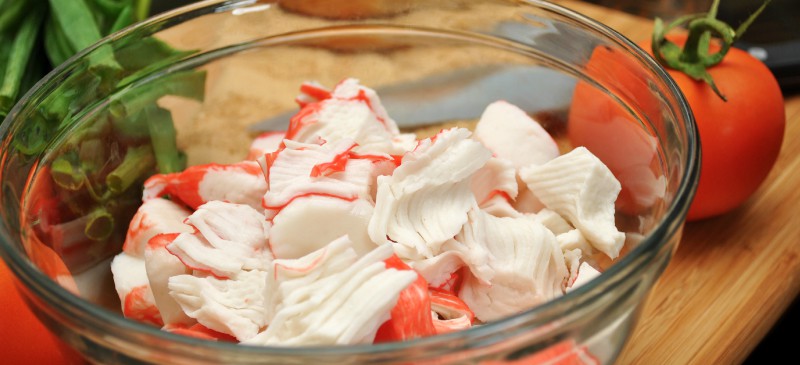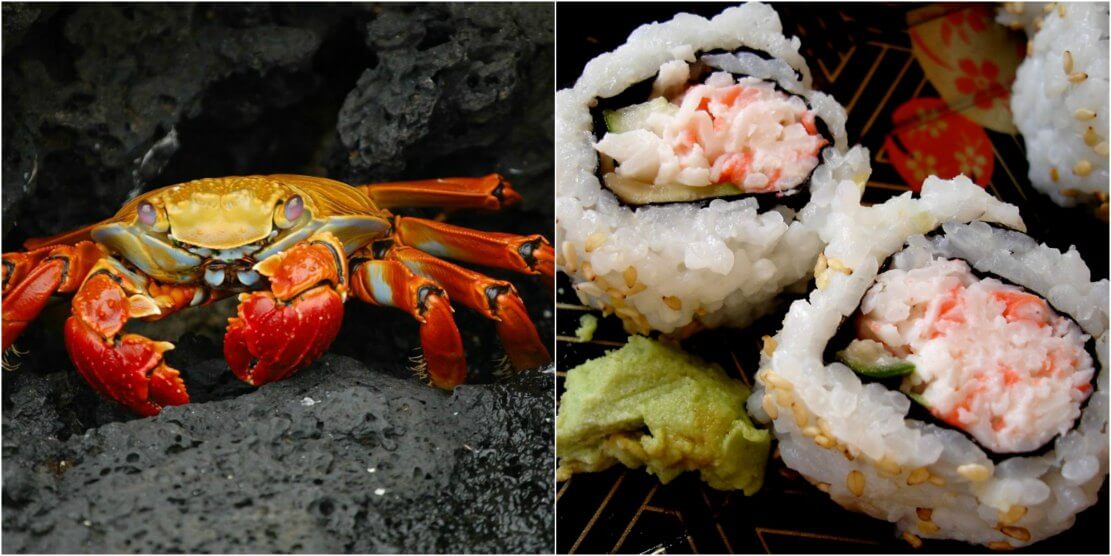What is Fake Crab Made of?
What is Fake Crab Made of? For many, the allure of crab meat lies in its delicate taste and flakey texture. However, the cost of real crab meat can often be a deterrent, prompting many to explore alternatives. Enter fake crab, a seafood imposter that has gained immense popularity in recent years. But have you ever stopped to wonder what exactly lies behind that uncanny resemblance to real crab?
Surimi: The Foundation of Fake Crab

The key ingredient in fake crab is surimi, a Japanese invention dating back to the 12th century. This paste-like substance is made from finely ground, white-fleshed fish, typically pollock, cod, or hake. The fish is washed, descaled, and deboned before being minced and repeatedly washed to remove any blood or impurities.
The Process of Creating a Crab Illusion
The surimi paste undergoes a series of steps to transform it into the familiar crab-like sticks we see today. Here’s a breakdown of the process:
- Washing and Grinding: The surimi is washed again to ensure purity and then ground to a very fine consistency.
- Salt and Cryoprotectants: Salt is added for flavor and preservation, while cryoprotectants like sugar and sorbitol are added to prevent the surimi from freezing solid and losing its texture.
- Blending and Heating: Egg whites, starch, and vegetable oil are blended into the surimi paste, creating a smooth and workable mixture. This is then heated to set the proteins and enhance the texture.
- Flavoring and Coloring: Artificial or natural crab flavoring is added, along with food coloring to mimic the red and orange hues of real crab meat.
- Extrusion and Shaping: The flavored mixture is forced through molds that give it the familiar shape of crab legs, sticks, or other desired forms.
- Cooking and Packaging: The molded surimi is cooked, typically by steaming or boiling, to further firm the texture and ensure its shelf life. Finally, it is packaged and ready for distribution.
Beyond the Basic Ingredients: Additives and Concerns

While surimi forms the core of fake crab, a variety of other ingredients are added to enhance its flavor, texture, and appearance. Some of these additives, however, have raised concerns among health-conscious consumers:
- Sodium: Imitation crab is often high in sodium, which can contribute to high blood pressure and other health problems.
- Sugar: Some brands of imitation crab contain added sugar, which can increase your daily sugar intake and contribute to weight gain.
- Artificial Flavors and Colors: While these additives contribute to the desired crab-like taste and appearance, some individuals may prefer to avoid them.
- Preservatives: Certain preservatives, like sodium benzoate, may have potentially harmful effects on health, although research is ongoing.
Nutritional Value: Real vs. Fake Crab

When it comes to nutritional value, real crab meat comes out on top. It is a good source of protein, omega-3 fatty acids, vitamin B12, and selenium. Fake crab, on the other hand, is lower in protein and omega-3s but can still provide some protein and vitamin B12. However, it is significantly higher in sodium and sometimes contains added sugar and unhealthy fats.
The Bottom Line: Enjoying Fake Crab Responsibly
Fake crab can be a convenient and affordable alternative to real crab meat. However, it is important to be aware of its limitations. Opt for brands with lower sodium content and fewer artificial additives. Enjoy it in moderation and pair it with other healthy ingredients to create a delicious and balanced meal.
Beyond the Imitation: Exploring Sustainable Seafood Alternatives

While fake crab may offer a solution for those on a budget, it is important to consider the environmental impact of our seafood choices. Overfishing and unsustainable practices are pushing many fish populations to the brink. Exploring alternative seafood options, like sustainably farmed fish or lesser-known species, can help ensure the health of our oceans for generations to come.
In conclusion, fake crab may not be the real deal, but it offers a convenient and affordable seafood option. By understanding its composition, nutritional value, and potential downsides, you can make informed choices about how to incorporate it into your diet. Remember, moderation is key, and exploring sustainable seafood alternatives can help ensure a healthy future for our oceans.
Exploring Beyond Fake Crab: Sustainable Seafood Alternatives
While fake crab can be a convenient and affordable option, it’s important to remember that it’s a processed food with limitations. For those seeking a more sustainable and nutritionally dense alternative, exploring a diverse range of seafood options is crucial. Here are some alternatives to consider:
1. Farmed Fish:
Farmed fish, unlike wild-caught fish, are raised in controlled environments like ponds or tanks. This allows for more efficient production and can be a sustainable option if done responsibly. Look for fish raised on sustainable feed and in closed containment systems to minimize environmental impact. Some popular farmed fish options include:
- Salmon: A rich source of omega-3 fatty acids, protein, and vitamin B12.
- Tilapia: A mild-flavored fish suitable for various culinary applications.
- Catfish: A low-fat and versatile fish with a slightly sweet flavor.
2. Lesser-Known Species:
Many delicious and nutritious seafood options are often overlooked. Choosing lesser-known species can help reduce pressure on overfished populations and promote biodiversity. Some options to explore include:
- Sardines: Packed with protein, omega-3s, and vitamin D.
- Mackerel: A fatty fish rich in omega-3s and vitamin B12.
- Mussels: A sustainable and affordable source of protein, iron, and vitamin B12.
- Oysters: A good source of protein, zinc, and vitamin B12.
3. Bivalves:
Bivalves, like clams, oysters, and mussels, are filter feeders that help clean the water they live in. They are typically low in mercury and other contaminants and a good source of protein and essential nutrients.
4. Seaweed:
Seaweed is a sustainable and versatile ingredient gaining popularity. It’s a good source of dietary fiber, minerals, and antioxidants. You can enjoy seaweed in various ways, like adding it to salads, soups, or smoothies.
5. Plant-Based Seafood Alternatives:
Plant-based alternatives are gaining traction in the market, offering a sustainable and cruelty-free alternative to traditional seafood. These products are often made from ingredients like soy, pea protein, and seaweed and can mimic the taste and texture of fish, shrimp, and other seafood.
Choosing Sustainable Seafood:
When choosing seafood, look for certifications like the Marine Stewardship Council (MSC) or the Aquaculture Stewardship Council (ASC) to ensure it’s been caught or farmed responsibly. You can also ask your fishmonger about the origin and sustainability practices of their seafood.
Making informed choices about your seafood consumption is essential for both your health and the health of our planet. By exploring sustainable alternatives to fake crab, you can enjoy delicious and nutritious seafood while contributing to a healthier future for our oceans.

